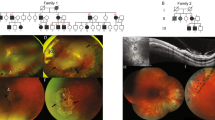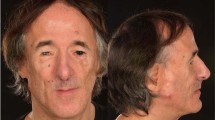Abstract
Stickler syndrome is an autosomal dominant connective tissue disorder caused by mutations in different collagen genes. The aim of our study was to define more precisely the phenotype and genotype of Stickler syndrome type 1 by investigating a large series of patients with a heterozygous mutation in COL2A1. In 188 probands with the clinical diagnosis of Stickler syndrome, the COL2A1 gene was analyzed by either a mutation scanning technique or bidirectional fluorescent DNA sequencing. The effect of splice site alterations was investigated by analyzing mRNA. Multiplex ligation-dependent amplification analysis was used for the detection of intragenic deletions. We identified 77 different COL2A1 mutations in 100 affected individuals. Analysis of the splice site mutations showed unusual RNA isoforms, most of which contained a premature stop codon. Vitreous anomalies and retinal detachments were found more frequently in patients with a COL2A1 mutation compared with the mutation-negative group (P<0.01). Overall, 20 of 23 sporadic patients with a COL2A1 mutation had either a cleft palate or retinal detachment with vitreous anomalies. The presence of vitreous anomalies, retinal tears or detachments, cleft palate and a positive family history were shown to be good indicators for a COL2A1 defect. In conclusion, we confirm that Stickler syndrome type 1 is predominantly caused by loss-of-function mutations in the COL2A1 gene as >90% of the mutations were predicted to result in nonsense-mediated decay. On the basis of binary regression analysis, we developed a scoring system that may be useful when evaluating patients with Stickler syndrome.
Similar content being viewed by others
Log in or create a free account to read this content
Gain free access to this article, as well as selected content from this journal and more on nature.com
or
References
Stickler GB, Belau PG, Farrell FJ et al: Hereditary progressive arthro-ophthalmopathy. Mayo Clin Proc 1965; 40: 433–455.
Stickler GB, Hughes W, Houchin P : Clinical features of hereditary progressive arthro-ophthalmopathy (Stickler syndrome): a survey. Genet Med 2001; 3: 192–196.
Majava M, Hoornaert KP, Bartholdi D et al: A report on 10 new patients with heterozygous mutations in the COL11A1 gene and a review of genotype-phenotype correlations in type XI collagenopathies. Am J Med Genet A 2007; 143: 258–264.
Snead MP, Yates JR : Clinical and molecular genetics of Stickler syndrome. J Med Genet 1999; 36: 353–359.
Richards AJ, Laidlaw M, Whittaker J et al: High efficiency of mutation detection in type 1 Stickler syndrome using a two-stage approach: vitreoretinal assessment coupled with exon sequencing for screening COL2A1. Hum Mutat 2006; 27: 696–704.
Ahmad NN, Ala-Kokko L, Knowlton RG et al: Stop codon in the procollagen II gene (COL2A1) in a family with the Stickler syndrome (arthro-ophthalmopathy). Proc Natl Acad Sci USA 1991; 88: 6624–6627.
Richards AJ, Yates JR, Williams R et al: A family with Stickler syndrome type 2 has a mutation in the COL11A1 gene resulting in the substitution of glycine 97 by valine in alpha 1 (XI) collagen. Hum Mol Genet 1996; 5: 1339–1343.
Vikkula M, Mariman EC, Lui VC et al: Autosomal dominant and recessive osteochondrodysplasias associated with the COL11A2 locus. Cell 1995; 80: 431–437.
Van Camp G, Snoeckx RL, Hilgert N et al: A new autosomal recessive form of Stickler syndrome is caused by a mutation in the COL9A1 gene. Am J Hum Genet 2006; 79: 449–457.
Spranger J, Winterpacht A, Zabel B : The type II collagenopathies: a spectrum of chondrodysplasias. Eur J Pediatr 1994; 153: 56–65.
Zankl A, Neumann L, Ignatius J et al: Dominant negative mutations in the C-propeptide of COL2A1 cause platyspondylic lethal skeletal dysplasia, torrance type, and define a novel subfamily within the type 2 collagenopathies. Am J Med Genet 2005; 133: 61–67.
Ganguly A, Rock MJ, Prockop DJ : Conformation-sensitive gel electrophoresis for rapid detection of single-base differences in double-stranded PCR products and DNA fragments: evidence for solvent-induced bends in DNA heteroduplexes. Proc Natl Acad Sci USA 1993; 90: 10325–10329.
Orita M, Iwahana H, Kanazawa H et al: Detection of polymorphisms of human DNA by gel electrophoresis as single-strand conformation polymorphisms. Proc Natl Acad Sci USA 1989; 86: 2766–2770.
Xiao W, Oefner PJ : Denaturing high-performance liquid chromatography: a review. Hum Mutat 2001; 17: 439–474.
Schouten JP, McElgunn CJ, Waaijer R et al: Relative quantification of 40 nucleic acid sequences by multiplex ligation-dependent probe amplification. Nucleic Acids Res 2002; 30: e57.
Harrell Jr FE, Lee KL, Mark DB : Multivariable prognostic models: issues in developing models, evaluating assumptions and adequacy, and measuring and reducing errors. Stat Med 1996; 15: 361–387.
Laupacis A, Sekar N, Stiell IG : Clinical prediction rules. A review and suggested modifications of methodological standards. JAMA 1997; 277: 488–494.
Spiegelhalter DJ : Probabilistic prediction in patient management and clinical trials. Stat Med 1986; 5: 421–433.
Van Der Hout AH, Verlind E, Beemer FA et al: Occurrence of deletion of a COL2A1 allele as the mutation in Stickler syndrome shows that a collagen type II dosage effect underlies this syndrome. Hum Mutat 2002; 20: 236.
Hoornaert KP, Dewinter C, Vereecke I et al: The phenotypic spectrum in patients with arginine to cysteine mutations in the COL2A1 gene. J Med Genet 2006; 43: 406–413.
Donoso LA, Edwards AO, Frost AT et al: Clinical variability of Stickler syndrome: role of exon 2 of the collagen COL2A1 gene. Surv Ophthalmol 2003; 48: 191–203.
McAlinden A, Majava M, Bishop PN et al: Missense and nonsense mutations in the alternatively spliced exon 2 of COL2A1 cause the ocular variant of Stickler syndrome. Hum Mutat 2008; 29: 83–90.
Richards AJ, Martin S, Yates JR et al: COL2A1 exon 2 mutations: relevance to the Stickler and Wagner syndromes. Br J Ophthalmol 2000; 84: 364–371.
Kielty C, Grant M : The collagen family: structure, assembly, and organization in the extracellular matrix; in Royce PM, Steinmann B, (eds).: Connective Tissue and its Heritable Disorders. Wiley Liss Inc.: New York, 2002; 159–222.
Schell T, Kulozik AE, Hentze MW : Integration of splicing, transport and translation to achieve mRNA quality control by the nonsense-mediated decay pathway. Genome Biol 2002; 3: REVIEWS1006.
Richards AJ, Laidlaw M, Meredith SP et al: Missense and silent mutations in COL2A1 result in Stickler syndrome but via different molecular mechanisms. Hum Mutat 2007; 28: 639.
Takahara K, Schwarze U, Imamura Y et al: Order of intron removal influences multiple splice outcomes, including a two-exon skip, in a COL5A1 acceptor-site mutation that results in abnormal pro-alpha1(V) N-propeptides and Ehlers-Danlos syndrome type I. Am J Hum Genet 2002; 71: 451–465.
Schwarze U, Starman BJ, Byers PH : Redefinition of exon 7 in the COL1A1 gene of type I collagen by an intron 8 splice-donor-site mutation in a form of osteogenesis imperfecta: influence of intron splice order on outcome of splice-site mutation. Am J Hum Genet 1999; 65: 336–344.
Wilkin DJ, Bogaert R, Lachman RS et al: A single amino acid substitution (G103D) in the type II collagen triple helix produces Kniest dysplasia. Hum Mol Genet 1994; 3: 1999–2003.
Tiller GE, Polumbo PA, Weis MA et al: Dominant mutations in the type II collagen gene, COL2A1, produce spondyloepimetaphyseal dysplasia, Strudwick type. Nat Genet 1995; 11: 87–89.
Richards AJ, Baguley DM, Yates JR et al: Variation in the vitreous phenotype of Stickler syndrome can be caused by different amino acid substitutions in the X position of the type II collagen Gly-X-Y triple helix. Am J Hum Genet 2000; 67: 1083–1094.
Zechi-Ceide RM, Jesus Oliveira NA, Guion-Almeida ML et al: Clinical evaluation and COL2A1 gene analysis in 21 Brazilian families with Stickler syndrome: identification of novel mutations, further genotype/phenotype correlation, and its implications for the diagnosis. Eur J Med Genet 2008; 51: 183–196.
Acknowledgements
We are grateful to the patients and their families for their cooperation. We thank the following clinicians for the referral of samples: M Ausems, M Baumgartner, K Becker, S Bertok, F Betis, AM Bisgaard, K Bouman, H Brunner, O Calabrese, K Chandler, S De Almeida, T De Ravel, K Devriendt, M Drolenga, I Feenstra, JP Fryns, H Fryssira, F Goodman, BCJ Hamel, JM Hertz, T Homfray, J Hurst, S Janssens, D Johnson, J Kamphoven, WS Kerstjens-Frederikse, K Keymolen, I Liebaers, M Maas, F Malfait, H Malmgren, S Mancini, S Mansour, I Mathijssen, T McDevitt, EJ Meijers, F Meire, A Mendicino, N Mignone, A Muellner-Eidenbock, R Newbury-Ecob, A Nordgren, C Postma, EM Ruiter, P Schmidt, C Schrander-Stumpel, F Stanzial, A Superti-Furga, K Ten Berg, P Terhal, S Tinschert, A Tzschach, D van den Boogaard, I Van Der Burgt, P Van Kerrebroeck, L Van Maldergem, N Van Regemorter, J Vigneron, AMC Vos, M Wright and A Zankl. This study was made possible by Grant no. G.0331.03 from the Research Foundation-Flanders (FWO) and GOA grant no. 12051203 from the Ghent University. Geert R Mortier is senior clinical investigator at the Research Foundation – Flanders (FWO). The corresponding author has the right to grant on behalf of all authors and does grant on behalf of all authors, an exclusive license (or non-exclusive for government employees) on a worldwide basis to the BMJ Publishing Group Ltd and its Licensees to permit this article (if accepted) to be published in the Journal of Medical Genetics and any other BMJPGL products to exploit all subsidiary rights, as set out in our license.
Author information
Authors and Affiliations
Corresponding author
Ethics declarations
Competing interests
The authors declare no conflict of interest.
Additional information
Supplementary Information accompanies the paper on European Journal of Human Genetics website
Rights and permissions
About this article
Cite this article
Hoornaert, K., Vereecke, I., Dewinter, C. et al. Stickler syndrome caused by COL2A1 mutations: genotype–phenotype correlation in a series of 100 patients. Eur J Hum Genet 18, 872–880 (2010). https://doi.org/10.1038/ejhg.2010.23
Received:
Revised:
Accepted:
Published:
Issue date:
DOI: https://doi.org/10.1038/ejhg.2010.23
Keywords
This article is cited by
-
Identification of three novel homozygous variants in COL9A3 causing autosomal recessive Stickler syndrome
Orphanet Journal of Rare Diseases (2022)
-
Mutation Spectrum of Stickler Syndrome Type I and Genotype-phenotype Analysis in East Asian Population: a systematic review
BMC Medical Genetics (2020)
-
A novel mutation in the COL2A1 gene in a patient with Stickler syndrome type 1: a case report and review of the literature
Journal of Medical Case Reports (2017)
-
A novel type II collagen gene mutation in a family with spondyloepiphyseal dysplasia and extensive intrafamilial phenotypic diversity
Human Genome Variation (2016)
-
Association between SCO2 mutation and extreme myopia in Japanese patients
Japanese Journal of Ophthalmology (2016)



